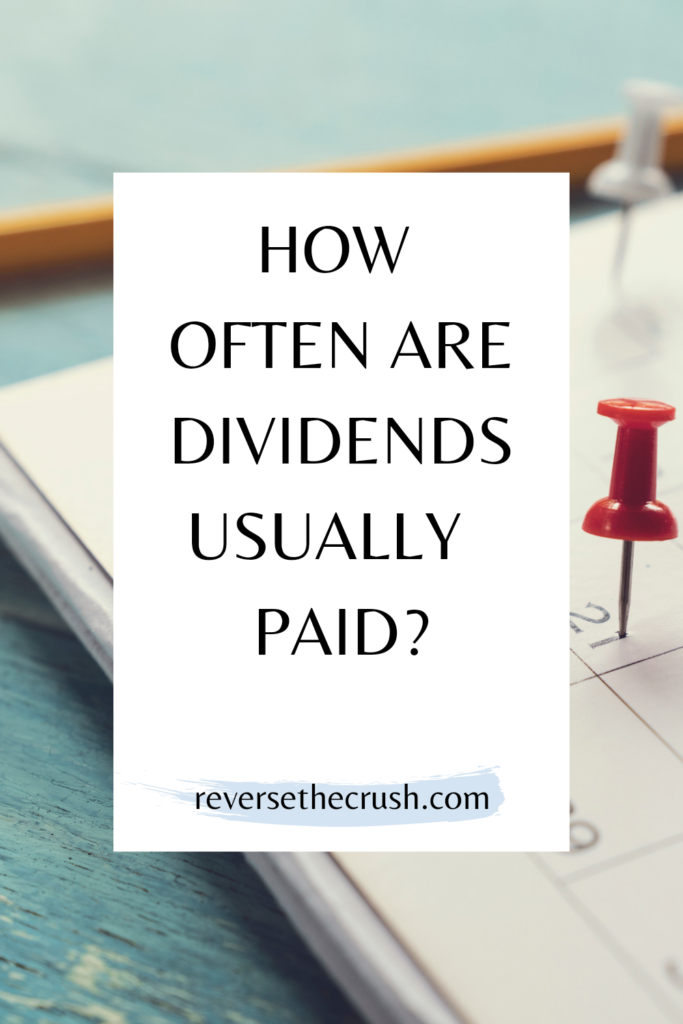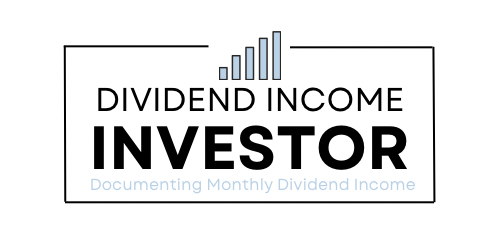How often are dividends usually paid? Find out when dividend investors get paid and how to get paid dividend income monthly. I am not a licensed investment advisor and this post is not investment advice.
More and more people are creating their own income stream with dividend investing these days.
Of course, it takes time to accumulate enough capital to acquire enough dividend paying stocks to cover your expenses.
But it’s entirely possible to reach financial independence through dividend investing with 10 to 15 years of aggressive saving and consistent investing.
The question is: how often are dividends usually paid?
In this post, I will look at when stocks pay dividends.
Let’s dive in.

How Often Are Dividends Usually Paid?
Stocks pay dividends quarterly to shareholders as of the ex-dividend date.
However, there are some stocks that pay dividends monthly, semi-annually, and annually.
Meanwhile, REITs (real estate investment trust) pay distributions monthly.
Dividends Pay Quarterly
Most common blue chip stocks pay dividends quarterly.
For example, Apple (AAPL) pays dividends quarterly. They pay dividends in August, November, February, and May of each year.
Proctor & Gamble (PG) is another example of a blue chip stock that pays quarterly dividends.
Although there are exceptions, dividends are usually paid quarterly.
REITs Pay Monthly
One of the most compelling reasons to own REITs is that they pay distributions monthly.
In turn, you can reinvest distributions more frequently and compound monthly.
However, the thing to remember with REITs is that distribution raises are rare.
In the long term, a quality dividend stock could end up paying a higher dividend yield compared to the original investment cost.
Personally, I invest in REITs as a small percentage of my portfolio to boost monthly income.
But the core of my portfolio are quality dividend growth stocks.
Related: Monthly Dividend REITs – 5 Reliable REITs That Pay Every Month
Ex-Dividend Date And Payment Date
To ensure that you that you receive the next dividend, you must own shares of a stock before the ex-dividend date.
As long as you own shares on the ex-dividend date, you will receive the next dividend payment on the payment date.
Although this is not necessarily that important for long term investors, it’s worth noting.
How Are Dividends Paid?
Dividends are deposited directly into the cash side of an investment account.
It will show up in the cash side of your account similar to how cash shows up after you contribute to your investment account.
If your brokerage offers DRIP (dividend reinvestment plan), you can choose to have dividends automatically reinvested back into more shares of the same stock. In turn, your dividend payment will be higher every quarter. Also, some stocks offer a discount on the share price through their DRIP. For example, shares purchased through a DRIP will be purchased at a 5% discount to the market price.
Personally, I utilize a DRIP for my Enbridge (ENB) position. Every quarter I own another share of ENB.
But for most of my holdings, I reinvest the dividends myself after they are deposited to my brokerage account.
How To Receive Dividends Monthly From Stocks
The long term goal for dividend investors is the dividend crossover point.
In short, the crossover point is when your dividend income exceeds your expenses.
If you want to receive an equal amount of dividend income monthly, you will have to own multiple stocks that pay dividends in different months.
For example, Royal Bank (RY) pays dividends in November, February, May, and August.
Meanwhile, Telus pays January, April, July, and October.
To round it off, ENB pays dividends in March, June, September, and December.
So, if you owned RY, T.TO, and ENB, you would receive dividends every month.
To ensure that you are properly diversified, own two to three dividend paying stocks per month.
Related: Stocks That Pay Dividends In February, May, August, And November

How Often Are Dividends Usually Paid? — Final Thoughts
In summary, most stocks pay dividends quarterly.
However, in some cases, they pay monthly, semi-annually, or annually.
REITs pay distributions monthly, so it’s nice to include REITs in a portfolio for additional income.
Moreover, check the ex-dividend and payment date to determine when the stocks you own pay dividends.
Once the dividend is deposited into your brokerage account, you can reinvest, withdraw, or leave it as cash.
Additionally, you could choose to DRIP it, if that option is available through your brokerage and if the stock offers a DRIP.
To receive monthly dividends, own multiple dividend stocks that pay on different months.
Personally, I reinvest all my dividend income almost immediately into more dividend growth stocks.
Here Are A Few Similar Dividend Investing Posts To Check Out
How Much Money Do I Need To Invest To Make $3,000 Per Month
What Is A Good Dividend Yield?
Dividend Investing Tips: Must-Know Tips For Dividend Investors
Stocks That Pay Dividends In February, May, August, And November
How Much Do I Need To Invest To Live Off Dividends?
I am not a licensed investment or tax adviser. All opinions are my own. This post may contain advertisements by Monumetric and Google Adsense. This post may also contains internal links, affiliate links to BizBudding, Amazon, Bluehost, and Questrade, links to trusted external sites, and links to RTC social media accounts.
Connect with RTC
Twitter: @Reversethecrush
Pinterest: @reversethecrushblog
Instagram: @reversethecrush_
Facebook: @reversethecrushblog
Email: graham@reversethecrush.com


 Buying Stocks Long Term — 5 Clear Benefits Of Long Term Investing
Buying Stocks Long Term — 5 Clear Benefits Of Long Term Investing
